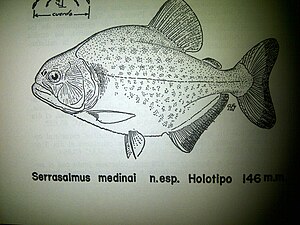Serrasalmus medinai
| Serrasalmus medinai | ||||||||||||
|---|---|---|---|---|---|---|---|---|---|---|---|---|

Drawing of the holotype of Serrasalmus medinai |
||||||||||||
| Systematics | ||||||||||||
|
||||||||||||
| Scientific name | ||||||||||||
| Serrasalmus medinai | ||||||||||||
| Ramírez , 1965 |
Serrasalmus medinai , Spanish Caribe Molichalero , engl. Red Throat Piranha , is a species of saw tetra from tropical South America . The specific epithet honors the biologist Dr. Gonzalo Medina.
description
Serrasalmus medinai reaches a standard length of 14.8 cm. The color is predominantly silvery with numerous large, black spots, similar to Pygocentrus cariba and Serrasalmus neveriensis , which get smaller towards the belly. The back is dark, the abdomen in adult animals is metallic reddish-orange, in young animals it is silvery. The head is silvery yellow on the sides and towards the belly. The iris is yellow, a dark band runs over the eye socket. There is a dark spot on the gill cover. The dorsal fin (dorsal) and the ventral fins (ventral) are transparent, the pectoral fins (pectorals) in adults are light reddish, in young animals also transparent. On the fleshy part of the anal fin (anal) there is a black band through tiny scales, the middle part is dark reddish-brown at the front with a dark band on the edge of the fin, the rear third is black. There is a wide dark band on the caudal peduncle, the rest of the caudal fin is transparent.
Serrasalmus medinai has 35 (34–36) vertebrae, 70 (63–75) scales along the lateral line, and 23 (20–25) abdominal teeth in front of and 10 (8–11) behind the pelvic fins.
distribution
The catchment area of the Orinoco in Venezuela . Type locality is El Polvero , Río San José in the state of Guárico .
Way of life
S. medinai feeds on whole small fish and on fins, scales and pieces of other fish. He also takes seeds and fruits. As young animals, they also eat aquatic insects and other invertebrates. The species reaches sexual maturity at one year. Spawning occurs in the first three months of the rainy season. A female lays over 3000 eggs with a diameter of 1.5 mm, the eggs can be laid more than once a year.
Systematics
Studies published in 2007 regard the genus Serrasalmus as monophyletic with three main clades . Serrasalmus medinai belongs to clade B 1 with S. brandtii , S. manueli and S. maculatus .
Notes and individual references
- ^ A b Donald C. Taphorn B .: Manual de identificación y biología de los peces characiformes de la cuenca del Río Apure en Venezuela. 2003, BioCentro Guanare, Estado Portuguesa, Venezuela. Pp. 39-40. ( Online ; PDF; 9.5 MB)
- ↑ a b Roberto E. Reis et al. : Check List of the Freshwater Fishes of South and Central America. 2003, ISBN 8574303615 , p. 191.
- ^ A b Oregon Piranha Exotic Fish Exhibit: Serrasalmus medinai
- ^ Antonio Machado Alison: Los peces de los llanos de Venezuela. 2005, ISBN 980002235X , pp. 86, 120.
- ↑ N. Hubert, F. Duponchelle, J. Nuñez, C. Garcia-Davila, D. Paugy & J.-F. Renno: Phylogeography of the piranha genera Serrasalmus and Pygocentrus: implications for the diversification of the Neotropical ichthyofauna. In: Molecular Ecology (2007) 16, pp. 2115-2136. ( Online ; PDF; 1.2 MB)
Web links
- Serrasalmus medinai on Fishbase.org (English)